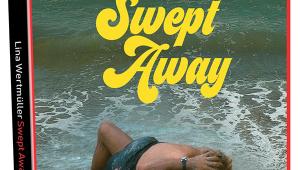Chilly Gonzales & Jarvis Cocker Request Our Presence in Room 29

Let us now give praise to the power of the almighty song cycle, that notable grouping of songs deigned to be performed in their exact sequence. And now let us give further praise to Room 29 (Deutsche Grammophon), a decidedly thrilling 16-track song cycle jointly concocted by vocalist/lyricist Jarvis Cocker (of Pulp fame) and composer/pianist Chilly Gonzales (Feist, Peaches, Daft Punk). From the baby-grand designs of “Tearjerker” to the quizzical drama of the title track to the deceptive confection of “Ice Cream as Main Course,” Room 29 is a place you can check out any time you like, but may never be able to leave.
Room 29 finds its true origins in and around a baby grand piano located in the same-numbered room on the second floor of the famed Chateau Marmont Hotel on Sunset Boulevard in West Hollywood. “When the Chateau Marmont was being built [in the late 1920s], that was also the time people began to have these gaps between fantasy and reality, vis a vis pop culture,” observes Gonzales (seated at the piano in the above photo). “And in that hotel, you’re confronting a fantasy. You’re wondering, ‘Is it going to be a fantasy land, am I going to have sex here, or will there be a crazy, decadent party — what’s going to happen here in this hotel room?’” One thing’s for sure: Whatever does wind up happening there will have a great soundtrack accompanying it.
Gonzales, 45, called in from his room across the Pond to discuss the sonics of Room 29, his and Cocker’s “reverse” song-cycle writing process, and how (yes) Gilligan’s Island fits into the middle of it all.
Mike Mettler: As the song cycle’s composer, how do you deal with the idea that some listeners will be more inclined to stream Room 29 than listen to it via higher-res downloads or vinyl?
Chilly Gonzales: I don’t deal with it. I’m not the one who listens to it that way.
Mettler: (laughs) OK, so how do you prefer it be listened to?
Gonzales: Everyone can choose their own way to listen. I don’t hold it against people who are into it in lower quality. Not everyone out there is a sound nerd or a music nerd. I try to keep that in mind when I make music so that it works on multiple levels. My instrumental piano records and my [2015] Chambers record, dynamically speaking, work as both background music and, hopefully, close-listening music as well.
I do know there are some people who want “nice” music for their dinner parties, and I don’t mind if that’s how they latch onto me. I also don’t mind if someone puts on the headphones. I also love it when people buy my sheet music and interact with the music in that way — to literally have my music come through their bodies by playing it themselves. That’s also amazing.
Everyone’s different. Everyone has different levels of intensity as to how they consume music. I’m glad there are people like you, because it keeps me remembering that it has to work on multiple levels. And I think Room 29 is an extremely good-sounding record for audiophiles.
Mettler: I totally agree. For example, I enjoy the subtleties in the way you and Jarvis are in tune together on the vocal tones and piano accompaniment on “Tearjerker.” When you and he are working on a song like that, how do work out the way you play along with its lyrical statement?
Gonzales: Well, I love to accompany Jarvis, because he’s not your typical “beautiful voice” singer. He’s a true man of letters when he’s performing. There’s so much low range in his voice, and he’s become — I don’t know if you know it over there in the States, but he has a great radio show called Jarvis Cocker’s Sunday Service on BBC Radio 6. It’s a really big thing in England and across Europe.
For that show, he found something different in his vocal persona than when he was in Pulp. He told me that most of the time with Pulp, he had to shout over an entire band. But here he was at this radio show developing this very intimate relationship with the microphone.
I think he carried that over to Room 29, where we have the first musical version of what he’s developed in his radio show, to a certain extent — including the research and all of the historical elements that come into play on Room 29 on occasion as well.
It’s a real joy to accompany someone like that. I can make the music almost as “pretty” as it could be, because it’s almost offset by the performance of Jarvis. Sometimes it’s gruff, sometimes it’s whispering, and sometimes it’s low in the mix, so I don’t have to play as much low left hand. I can go into having both hands if I want in the midrange or the high end of the piano.
Whereas if I’m accompanying Feist, someone I’ve worked with on her albums over the last 15 years, it’s very different. She has a very high voice and a very clear, bell-like tone. With her, I’m down in the bottom, usually, like growling at the piano, because you don’t want “pretty and pretty” going together — you always want to create a contrast.
To accompany Jarvis is a real pleasure. He inhabits the song in a slightly different way each time. He can choose the moments to come in and out of the melody, because most of the time, the melody is in the right hand as well. It’s a little bit like those old Leonard Cohen albums, where there was a female vocalist very clearly outlining the melody. Leonard could choose when he wanted to sing along with that melody, or just speak, or just grunt. (chuckles)
Jarvis can do that with my right hand on the piano, because he’s sort of the equivalent of that female voice on those Leonard Cohen albums. And every time, he breaks that up in different ways. He’ll sing something or he’ll speak something. He’ll make a line specifically tragic or resigned in one take, or a show of defiance in another. It’s like working with an actor who’s inhabiting the role differently every time.
And that’s what you want when you’re accompanying a singer — you want to feel present every time, just as present as I would when I’m alone onstage.
Mettler: Throughout this entire Room 29 song cycle, you’ve been expert at matching melody with message.
Gonzales: That’s right. Although you do know that we wrote in the backwards sense of how most song cycles are written, which is the composer chooses the poems and songs to use, but here, the music came first. Rather than the composer doing what we would call word painting, Jarvis was sort of doing reverse word painting, which I guess we’d have to call. . . (pauses) note verbalizing.
It was very interesting to me, because when I first sent him the music, Jarvis would write to whatever I would send him, and not ask for any changes. I would send him five or six things, and he would choose one or two to work on. After we had three or four, I realized, “Wow, these songs are really short.” I always thought he would say, “Take this bit and turn it into a chorus,” and instead, he took it as a fait accompli: “I’m going to write to this, and trust that the music has that structure for a reason.”
He just took that as an unquestioned source for him to write to, and those kind of constraints actually give people like Jarvis that freedom. They want the maximum amount of limitations, and then they feel quite free. It would feel like a can of worms to him to take it as “source” material.
I stopped sending him 2-minute pieces once I realized he was really writing to whatever I sent him. I started sending him what I thought were more finished things with interesting chutes and ladders, and lots of interesting pieces with more time — just making sure I sent him longer things, basically. That was the real difference.
That was one of the interesting things about working with him, and why it took such a long time — about 4 or 5 years, by the time we finished it. It was like, “OK, let’s really try to take the time to figure this out, rather than talk about it or feel the pressure of having to book studio time.” We really waited until it was good and ready, and that’s a bit of a luxury. You can actually discover, “Oh, what an interesting way this guy is working! He’s just writing to whatever I send. Let me take this into account now.”
We learned each song by doing it, rather than just talking about it. And we weren’t often in the same room.
Mettler: So you were rarely in the same place. Were you mainly sending Jarvis files to work with?
Gonzales: I just sent him piano. He would record vocals, and then he’d send it back. It’s acoustic music, so it was very straightforward. I invited him to perform some of the songs with me in 2014 at the Philharmonie Köln in Cologne, Germany [on December 29, 2014]. I think we had four or five songs by then, but we decided on three we felt really comfortable with. We did “Tearjerker,” “Bombshell,” and “Ice Cream as Main Course.”
As we performed them, we realized the German audience was hanging on every word. It was like, “Oh, cool; these songs are really connecting! Great!” That helped push us to go a bit further. And after playing them together, there was very little modification, and almost no changes he would ask for. We had this demo, and we waited for the next opportunity to go in the studio or play it live. And I would have to relearn it from the demo because probably 8 months had gone by — “what is this, exactly?” — and then we would just go and do it.
We learned them all by doing, but other than that, the composition happened invisibly, to me. I would send the piano demo and wait weeks, months, and, in some cases, years before he had something he felt was done.
We didn’t record any songs that didn’t make the album. Not a note or a word was put into this album without it making the final cut. And that’s a very different process for me, as I usually have to write dozens and dozens of songs and have to hone in on the repertoire of the album.
This was different, and I guess that’s what makes it a song cycle. It has a logical beginning, middle, and end. There was a moment where we thought the story was told, and that’s when we realized the album was done.
Mettler: And most especially in this case, the sequencing is uber-important for us to get the scope of the whole story, rather than cherry-pick our way through it. “Trick of the Light” has to be in position 14 in the song cycle. It couldn’t be in position 3 like “Tearjerker” is on the front end of it.
Gonzales: That’s right. The idea is these songs are being done in this order because this is what the story demands.
But, of course, we would like to think there are enough songs on the album that work as standalones, pieces that don’t have a complicated documentarian history to them. I’d like to think a song like “Tearjerker” holds up as just a good pop song. We’re not insensitive to the fact that not everybody listens to albums in their proper sequence as compared to 20 or 30 years ago.
But that was always the case — people would cherry-pick singles, and sometimes people would just listen to one side of an album because they were lazy, and didn’t want to turn their album over! (both chuckle)
It’s always been an arbitrary thing. In the classical world, there were no time limits on things when recording was not an option. You wrote your symphony, and it was however long as it had to be. You wrote your opera, and sometimes it was 2 hours, sometimes it was 3 hours. You wrote your song cycle based on the poems you had.
We’re not naïve, and we realize we do have to come up with a product that has to be within a certain time length for it to be one album without shooting ourselves in the foot. You do have to make a compromise as to where it’s at, realistically. You can’t release an album that’s only 20 minutes, because then you’d have to call it an EP. If you have a double album, you’re going to scare everybody off.
Mettler: The final question, then, is a very important one for Room 29, since it was mentioned specifically in the title track: Where is Gilligan’s Island? Do we know?
Gonzales: Well, Gilligan’s Island is a place that’s most definitely in both of our minds. When we bonded about this idea, I said to Jarvis, “What’s funny about this is, I’m not a big Hollywood historian.” I didn’t grow up with Hollywood movies except for what I saw on TV. And both Jarvis and I watched a lot of TV as kids — including Gilligan’s Island, of course.
In a way, the interest in Hollywood came later as the origin story of the current pop culture that we have, whether it’s the TV we grew up with or the digital screens we have that keep on getting smaller. It went from the movie screen, which was mind-blowing to the world — seeing this edited version of life up on a screen was a gamechanger, culturally — that got shortened and shrunk down to the TV size, and now it’s shrunk down even further.
So collectively between myself and Jarvis, when we both saw Gilligan’s Island on TV as kids, we both went, “Ohhh, I want to go live there! It’s better there!” We both became performers and personas, and we owe a good bit of that potentially by being raised, in a large way, by the TV. It’s a funny line in the song, but like most of Jarvis’s funny lines, it has a deep core, and a deeper meaning.
Mettler: To borrow another line, you’re going to Gilligan’s Island in your mind.
Gonzales: That’s right! In that hotel, you’re confronting a fantasy, and you’re wondering, “What’s going to happen in this hotel room? Is it going to be a fantasy land, am I going to have sex here, or will there be a crazy, decadent party — what’s going to happen here?” And that is a moment where you’re essentially saying, “Where is Gilligan’s Island? Where can I escape to?”
A lot of times that doesn’t happen, and you realize you’re in this very strange neutral environment, in a hotel without any personality at all. A hotel room is the most generic sad thing, in a way.
























































